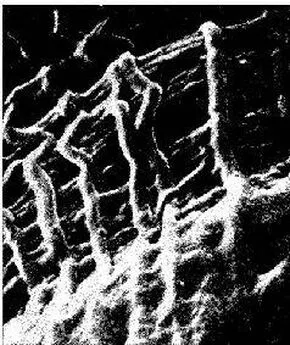Рик Хансон - Мозг и счастье. Загадки современной нейропсихологии
- Название:Мозг и счастье. Загадки современной нейропсихологии
- Автор:
- Жанр:
- Издательство:неизвестно
- Год:неизвестен
- ISBN:нет данных
- Рейтинг:
- Избранное:Добавить в избранное
-
Отзывы:
-
Ваша оценка:
Рик Хансон - Мозг и счастье. Загадки современной нейропсихологии краткое содержание
Книга известных ученых-нейропсихологов – невиданное ранее сочетание психологии, неврологии и техник самосовершенствования. Опираясь на новейшие достижения науки, авторы проникают в самые глубины человеческого мозга и показывают его взаимосвязь с психикой. С помощью этой книги вы сможете повысить эффективность работы своего мозга, развить лучшие личные качества и тем самым улучшить свою жизнь. В книге много нестандартных практических рекомендаций, поясняющих иллюстраций, эффективных упражнений, увлекательных примеров.
Перевод: Вера Штаерман
Мозг и счастье. Загадки современной нейропсихологии - читать онлайн бесплатно ознакомительный отрывок
Интервал:
Закладка:
Morris, M. C., D. A. Evans, C. C. Tangney, J. L. Bienias, R. S. Wilson,
N. T. Aggarwal and P. A. Scherr. 2005. Relation of the tocopherol forms to incident Alzheimer disease and to cognitivechange. American Journal of Clinical Nutrition 81:508–514.
Muller, S. F. Santorelli, F. Urbanowski, A. Harrington, K. Bonus and
J. F. Sheridan. 2003. Alterations in brain and immunefunction produced by mindfulness meditation. Psychosomatic Medicine 65:564–570.
Murray, R. K., D. K. Granner, P. A. Mayes and V. W. Rodwell. 2000. Harper’s Biochemistry , 25th ed. New York: McGraw-Hill.
Nanamoli, B. and B. Bodhi. 1995. The Middle Length Discourses of the Buddha: A Translation of the Majjhima Nikaya (Teachings of the Buddha). Boston: Wisdom Publications.
Niedenthal, P. 2007. Embodying emotion. Science 316:1002.
Nimchinsky, E., E. Gilissen, J. Allman, D. Perl, J. Erwin and P. Hof. 1999. A neuronal morphologic type unique to humans and great apes. Proceedings of the National Academy of Science 96:5268–5273.
Norenzayan, A. and A. F. Shariff. 2008. The origin and evolution ofreligious prosociality. Science 322:58–62.
Nowak, M. 2006. Five rules for the evolution of cooperation. Science 314:1560–1563.
Oberman, L. M. and V. S. Ramachandran. 2007. The simulatingsocial mind: The role of the mirror neuron system and simulationin the social and communicative deficits of autism spectrumdisorders. Psychology Bulletin 133:310–327.
O’Reilly, R. 2006. Biologically based computational models of highlevel cognition. Science 314:91–94.
Pare, D., D. R. Collins and J. G. Pelletier. 2002. Amygdala oscillationsand the consolidation of emotional memories. Trends in Cognitive Sciences 6:306–314.
Park, M., G. W. Ross, H. Petrovitch, L. R. White, K. H. Masaki,
J. S. Nelson, C. M. Tanner, J. D. Curb, P. L. Blanchette and R.
D. Abbott. 2005. Consumption of milk and calcium in midlife and the future risk of Parkinson disease. Neurology 64:1047–1051.
Paus, T. 2001. Primate anterior cingulate cortex: Where motor control, drive and cognition interface. Nature Reviews Neuroscience 2:417–424.
Pedata, F., L. Giovannelli, G. Spignoli, M. G. Giovannini and
G. Pepeu. 1985. Phosphatidylserine increases acetylcholinerelease from cortical slices in aged rats. Neurobiology of Aging 6:337–339.
Peeters, G. and J. Czapinski. 1990. Positive-negative asymmetry inevaluations: The distinction between affective and informational negativity effects. In European Review of Social Psychology: Volume 1 , edited by W. Stroebe and M. Hewstone. New York: Wiley.
Petrovic, P., R. Kalisch, T. Singer and R. J. Dolan. 2008. Oxytocin attenuates affective evaluations of conditioned faces andamygdala activity. Journal of Neuroscience 28:6607–6615.
Pitcher, D., L. Garrido, V. Walsh and B. C. Duchaine. 2008. Transcranial magnetic stimulation disrupts the perception andembodiment of facial expressions. The Journal of Neuroscience 28:8929–8933.
Posner, M. I. and M. K. Rothbart. 2000. Developing mechanisms of self-regulation. Development and Psychopathology 12:427–441.
Puri, B. K. 2006. High-resolution magnetic resonance imaging sincinterpolation-based subvoxel registration and semi-automatedquantitative lateral ventricular morphology employing thresholdcomputation and binary image creation in the study of fattyacid interventions in schizophrenia, depression, chronic fatigue syndrome and Huntington’s disease. International Review of Psychiatry 18:149–154.
Quirk, G. J., J. C. Repa and J. E. LeDoux. 1995. Fear conditionin genhances short-latency auditory responses of lateral amygdalaneurons: Parallel recordings in the freely behaving rat. Neuron 15:1029–1039.
Rabinovich, M., R. Huerta and G. Laurent. 2008. Transient dynamics for neural processing. Science 321:48–50.
Raichle, M. 2006. The brain’s dark energy. Science 314:1249–1250.
Raichle, M. and D. Gusnard. 2002. Appraising the brain’s energy-budget. Proceedings of the National Academy of Sciences 99:10237–10239.
Raichle, M. E., A. M. MacLeod, A. Z. Snyder, W. J. Powers, D. A. Gusnard and G. L. Shumlan. 2001. A default mode of brainfunction. Proceedings of the National Academy of Sciences 98:676–682.
Rasia-Filho, A., R. Londero and M. Achaval. 2000. Functional activitiesof the amygdala: An overview. Journal of Psychiatry and Neuroscience 25:14–23.
Rilling, J., D. Gutman, T. Zeh, G. Pagnoni, G. Berns and C. Kilts. 2002. A neural basis for social cooperation. Neuron 35:395–405.
Robinson, P. 2007. How to fill a synapse. Science 316:551–553.
Rosenberg, M. 2008 Second Edition. Nonviolent Communication: A Language of Life . Chicago: Puddledancer Press.
Sapolsky, R. M. 1998. Why Zebras Don’t Get Ulcers . New York: W. H. Freeman Co.
Schechner, S. 2008. Keeping love alive. Wall Street Journal , February 8, W1.
Schore, A. 2003. Affect Regulation and the Repair of the Self. New-York: W. W. Norton.
Seligman, M. 2006. Learned Optimism: How to Change Your Mind and Your Life . New York: Vintage/Random House.
Semaw, S., S. Renne, J. W. K. Harris, C. S. Feibel, R. L. Bernor,
N. Fesseha and K. Mowbray. 1997. 2.5-million-year-old stone tools from Gona, Ethiopia. Nature 385:333–336.
Shantideva. 1997. The Way of the Bodhisattva: A Translation of the-Bodhicharyavatara . Boston: Shambhala.
Shutt, K., A. MacLarnon, M. Heistermann and S. Semple. 2007.
Grooming in Barbary macaques: Better to give than to receive?
Biology Letters 3:231–233.
Siegel, D. J. 2001. The Developing Mind . New York: Guilford Press.
Silk, J. B. 2007. Social components of fitness in primate groups. Science 317:1347–1351.
Simpson, S. W., J. Quade, N. E. Levin, R. Butler, G. Dupont-Nivet,
M. Everett and S. Semaw. 2008. A female Homo erectus pelvis from Gona, Ethiopia. Science 322:1089–1092.
Singer, T. 2006. The neuronal basis and ontogeny of empathy and mind reading. Neuroscience and Biobehavioral Reviews 30:855–863.
Singer, T., B. Seymour, J. O’Doherty, H. Kaube, R. J. Dolan and
C. D. Frith. 2004. Empathy for pain involves the affective but not sensory components of pain. Science 303:1157–1162.
Singer, T., B. Seymour, J. O’Doherty, K. Stephan, R. Dolan and
C. Frith. 2006. Empathic neural responses are modulated by the perceived fairness of others. Nature 439:466–469.
Singh, M. 2005. Essential fatty acids, DHA and human brain. Indian Journal of Pediatrics 72:239–242.
Spagnoli, A., U. Lucca, G. Menasce, L. Bandera, G. Cizza, G. Forloni, M. Tettamanti, L. Frattura, P. Tiraboschi, M. Comelli, U. Senin, A. Longo, A. Petrini, G. Brambilla, A. Belloni, C. Negri,
F. Cavazzuti, A. Salsi, P. Calogero, E. Parma, M. Stramba-Badiale, S. Vitali, G. Andreoni, M. R. Inzoli, G. Santus, R. Caregnato, M. Peruzza, M. Favaretto, C. Bozeglav, M. Alberoni, D. de Leo, L. Serraiotto, A. Baiocchi, S. Scoccia, P. Culotta and
D. Ieracitano. 1991. Long-term acetyl-L-carnitine treatment in Alzheimer’sdisease. Neurology 41:1726.
Spear, L. P., 2000. The adolescent brain and age-related behavioral manifestations. Neuroscience Biobehavior Review 24:417–463.
Stern, D. 2000. The Interpersonal World of the Infant. New York: Basic Books.
Su, K., S. Huang, C. Chiub and W. Shenc. 2003. Omega-3 fatty acids in major depressive disorder: A preliminary double-blind, placebo-controlled trial. European Neuropsychopharmacology 13:267–271.
Sumedho, A. 2006. Trust in awareness. Talk given at Chithurst Monastery, Chithurst, UK, February 25.
Sun, Q. Q., S. S. Xu, J. L. Pan, H. M. Guo and W. Q. Cao. 1999. Huperzine-A capsules enhance memory and learning performancein 34 pairs of matched adolescent students. Zhongguoyao li xue bao [ Acta Pharmacologica Sinica ] 20:601–603.
Takahashi, H., M. Kato, M. Matsuura, D. Mobbs, T. Suhara and Y. Okubo. 2009. When your gain is my pain and your pain ismy gain: Neural correlates of envy and schadenfreude. Science 323:937–939.
Tanaka, J., Y. Horiike, M. Matsuzaki, T. Miyazka, G. Ellis-David and H. Kasai. 2008. Protein synthesis and neurotrophin-dependent structural plasticity of single dendritic spines. Science 319:1683–1687.
Tang, Y., Y. Ma, J. Wang, Y. Fan, S. Feg, Q. Lu, Q. Yu, D. Sui,
M. Rothbart, M. Fan and M. Posner. 2007. Short-term meditation training improves attention and self-regulation. Proceedings of the National Academy of Sciences 104:17152–17156.
Taylor, S. E., L. C. Klein, B. P. Lewis, T. L. Gruenewald, R. A. R. Gurung and J. A. Updegraff. 2000. Biobehavioral responsesto stress in females: Tend-and-befriend, not fight-or-flight. Psychological Review 107:411–429.
Thera, N. 1993. The four sublime states: Contemplations on love, compassion, sympathetic joy and equanimity. Retrieved fromhttp://www.accesstoinsight.org/lib/authors/nyanaponika/wheel006.html on April 3, 2009.
Thompson, E. 2007. Mind in Life: Biology, Phenomenology and the Sciences of Mind . Cambridge, MA: Harvard University Press.
Thompson, E. and F. J. Varela. 2001. Radical embodiment: Neural dynamics and consciousness. Trends in Cognitive Sciences 5:418–425.
Tucker, D. M., D. Derryberry and P. Luu. 2000. Anatomy and physiology of human emotion: Vertical integration of brain stem, limbic and cortical systems. In Handbook of the Neuropsychology of Emotion , edited by J. Borod. London: Oxford University Press.
Vaish, A., T. Grossmann and A. Woodward. 2008. Not all emotion sare created equal: The negativity bias in social-emotional development. Psychological Bulletin 134:383–403.
Vaitl, D., J. Gruzelier, G. Jamieson, D. Lehmann, U. Ott, G. Sammer,
U. Strehl, N. Birbaumer, B. Kotchoubey, A. Kubler, W. Miltner,
P. Putz, I. Strauch, J. Wackermann and T. Weiss. 2005. Psychobiology of altered states of consciousness. Psychological Bulletin 133:149–182.
Vogiatzoglou, A., H. Refsum, C. Johnston, S. M. Smith, K. M. Bradley, C. de Jager, M. M. Budge and A. D. Smith, 2008. Vitamin B12 status and rate of brain volume loss in community-dwellingelderly. Neurology 71:826–832.
Walsh, R. and S. L. Shapiro. 2006. The meeting of meditative discipline sand Western psychology: A mutually enriching dialogue. American Psychologist 61:227–239.
Wilson, E. O. 1999. Consilience: The Unity of Knowledge . London: Random House/Vintage Books.
Wolf, J. L. 1995. Bowel function. In Primary Care of Women , edited by K. J. Carlson and S. A. Eisenstat. St. Louis, MO: Mosby-Year Book, Inc.
Wu, W., A. M. Brickman, J. Luchsinger, P. Ferrazzano, P. Pichiule, M. Yoshita, T. Brown, C. DeCarli, C. A. Barnes, R. Mayeux,
S. Vannucci and S. A. Small. 2008. The brain in the age of old: The hippocampal formation is targeted differentially by diseases of late life. Annals of Neurology 64:698–706.
Yamasaki, H., K. La Bar and G. McCarthy. 2002. Dissociable prefrontal brain systems for attention and emotion. Proceedings of the National Academy of Sciences 99:11447–11451.
Yang, E., D. Zald and R. Blake. 2007. Fearful expressions gain preferential access to awareness during continuous flash suppression. Emotion 7:882–886.
Читать дальшеИнтервал:
Закладка:










